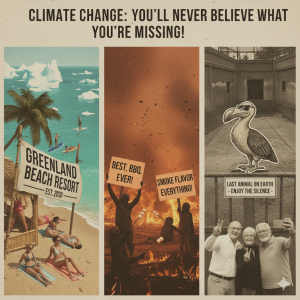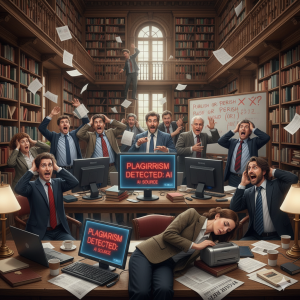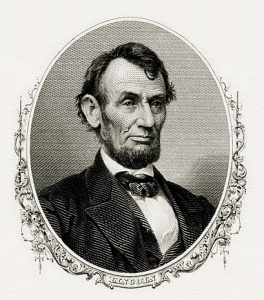By Don Mousted
Thank you for joining me this morning in the President’s absence. I would ask that you listen closely to what I have to say, then read the entire memo several times and discuss it together as well. Your help in this matter will prove invaluable. Let us face facts. One of the most pressing problems facing this country today is homelessness. It is estimated that 550,000 people are without shelter on any given day in the United States.
Not only is it ugly and disgraceful that this grim multitude huddles on the streets of our cities, cluttering up heated subway grates and pilfering our large cardboard boxes in which to sleep. It also lends credence to the baseless supposition that our former leaders from our side of the aisle, unconcerned with the problem, ignored its beginnings and thus begat the problem we see today.
This is categorically untrue, and smacks of the usual narrow-minded, whining, liberal criticism that is still in vogue to this day. George H.W. Bush attempted to summon forth the good works of “a thousand points of light.” Ronald Reagan went so far as to intercede in the sad case of Ferdinand Marcos, a homeless person from the Philippines, by sheltering both this man and his wife when nobody else would take them in–the selfsame depth of commitment and compassion that we have come to expect of our present Republican leadership. These were men that demonstrated the depth of their concern!
It is in this spirit–the 1980’s American spirit of concern for the downtrodden–that I propose the following, three-pronged attack on homelessness, primarily to offer a viable, cost-effective and final solution to the problem. Further, it is hoped that the adoption of these ideas will encourage those persons hovering on the abyss of homelessness to reconsider this decision, opting instead for a swift re-entry into the nation’s work force. Finally, it is meant to serve as an offering to our Senate and Tea Party House leaders to help them dispel the foul distortion that they are somehow insensitive to this issue. I believe that all right-thinking people will grasp the efficacy of these proposals and quail, as I do, at the consequences which must necessarily result from a continuation of our outmoded, mawkish policies toward the homeless.
Finally, New York City is used as a model throughout this proposal. The author intends no bias against other areas of the country (anticipating the inevitable assaults of a few effete critics who may choose to savage me on this point). I trust that the excluded municipalities will take no offense but, rather, will espouse these solutions, adapting them for use in their own communities as effective methods to break the enervating strangle hold of homelessness that suffocates us all today.
S.M.
2019
I. C.A.R.S.E.A.R.C.H.: A Program to Foster Creative Thinking
(Voluntary Participation)
In the morning, New Yorkers sit or stand, crowded into subway cars on their way to work. They are sheep–a captive audience–and ripe for shearing. As they attempt to read their folded newspapers and dog-eared books, desperate to avoid molestation, they are usually accosted by at least one person asking for their hard-earned money. At times there seems to be a veritable army of disheveled people shuffling past—one immediately following another—who has just left. [1]
Contributions are collected in either a crumpled paper bag or a dirty blue and white cup with Athenian statuary and hieroglyphics encircling its perimeter. While some approaches are passive in style, others may be rather intimidating: Sometimes they are treated to an a capella song–usually “We Are The World”–for “your entertainment;” other times they may be confronted by a feral-eyed “Vietnam veteran” (who is at most, 25) “trying to get my life together, dammit,” or else lulled by the lilting litany, “Pennies for the homeless children…pennies for the homeless children…”
However, discounting style, there appears to have been a dramatic improvement in the general quality level of these performances. This hopeful trend has sparked the idea that a weekly talent show featuring the able homeless might be just the ticket to spur a sense of self-actualization and pride in these needy individuals. This, then, is my primary proposal, C.A.R.S.E.A.R.C.H. (Competitive Artistic Reward System for the Enhancement And Recognition of the Competent Homeless).
Passengers on each subway line have grown accustomed to these talented beggars and have probably developed a grudging affection for their particular favorites. In order to be scrupulously fair, contestant nominations from passengers would be made by secret ballot, collected daily from every subway stop, placed into a 55-gallon drum, and transported under guard to the Price Waterhouse accounting firm for tabulation, thus insuring that no stigma would be attached to performers from the J or the LL trains. They would compete on an equal footing with those who frequent the more upscale #4, #5 and #6 trains on the East Side. Categories for the competition would be as follows:
BEST VOCALIST/INSTRUMENTALIST[2]
BEST ORIGINAL POETRY
MOST ORIGINAL STORY OF PERSONAL HARDSHIP
BEST COSTUMING
MOST HEART-RENDING CARDBOARD SIGN[3]
Two contestants will be selected in each category, and television cameras will be positioned in a specially-adapted subway car on the #1 train. This train has been chosen because it runs the entire length of Manhattan, is local, and is generally clean and air-conditioned so as not to offend the home viewing audience with obscene graffiti and profusely sweating bodies.
The rules are simplicity itself. As the program begins to the strains of “Brother, Can You Spare A Dime,” each contestant will be introduced by Anthony Scaramucci or a reasonable facsimile. Other possible hosts for the show, because of their present or impending availability, are Bill DiBlasio, Alexandra Ocasio-Cortez, Hillary Clinton or any present member of the New York Knicks or Mets.
Contestants will have 3 local stops between South Ferry and 215th Street during which to perform/display his or her particular specialty and collect money from the “studio” audience. Again, in order to insure fairness, the audience will be selected equally from the ridership of all subway lines.
The contestants will then move into the adjoining car where a Certified Public Accountant from Price Waterhouse will tally the money he or she has amassed. The contestant in each category who collects the most money is the winner. In case of a tie, there will be a tie-breaker round performed between 215th & 242nd streets. (NOTE: This section of the #1 train route runs through the Bronx and, for reasons of personal safety, tie-breakers should be avoided at all costs).
Losing contestants will be allowed to keep the money they have collected and, as a consolation prize, will be given one-way transportation to the homeless shelter or New Jersey metropolis of their choice. Although losers will be ineligible to compete in C.A.R.S.E.A.R.C.H. again for a period of six months, they are very likely to qualify for participation in either the second or third section of this proposal, so all is not lost!
In addition to the collected money, winning contestants will receive a genuine C.A.R.S.E.A.R.C.H. tin cup with his or her name and the inscription “C.A.R.S.E.A.R.C.H. WINNER” embossed on it with colorful plastic Dymo labels, and one week’s lodging at one of HUD’s exciting Section 8 Moderate Rehabilitation Single Room Occupancy (SRO) hotels in the heart of lower Manhattan, where they will have time to prepare in luxury for the following week’s competition. Sheets will be changed once every two weeks and laundry service is gratis–and required.
Welfare families formerly housed in these facilities have recently been relocated. This propitious development has eliminated the potential distraction of too many mewling waifs complaining about lack of heat or food and affords to the winners a space in which to concentrate their attention on preparing for the next contest. Prizes for continuing winners in the succeeding rounds will be decided upon once this proposal has been adopted.
In conclusion, if this program is to become a benchmark for reform, other major cities must embrace it as an inexpensive means of assisting their functional homeless. For example, the city of San Francisco would provide hearty competition for New York, given its extensive BART rail system and large, arts-minded Gay Community. Prizes would be increased commensurately to reflect the national status of the participants[4]
II. N.I.R.V.A.N.A. A Service to Medical Research
(Voluntary & Conscripted Participation)
The second class of homeless people to be dealt with are the addicted, afflicted, and aged. A comprehensive program designed to reduce their suffering is necessary now, possibly more than at any other time in our history, given the scourges currently attacking our fabric of life: Our modern-day apocalyptic horsemen, drug, opioid and alcohol addiction and AIDS.
Although billions of dollars are poured into research in these areas every year by the government and by philanthropic private foundations and individuals, progress has slowed to a snail’s pace. This is not due to a lack of dedicated researchers or because proper facilities are not available. Most often these scientists are forced to cope with wholly inadequate, noisy animal subjects which do not have the same physiology as Homo Sapiens. At times, human cadavers are made available, but these are in short supply and may have died in a manner unrelated to the pertinent scope of the research.
Even if the subject cadaver has died of the correct pathology, the afflicted organs may have degenerated into scarred, hardened husks–of little use in unlocking the step-by-step progression which resulted in their dysfunction. The key to solving this problem (while furthering the war on homelessness), is a bold, provocative, and cost-effective plan, N.I.R.V.A.N.A. (National Interaction of Researchers and Volunteers to Assist the Narcotized and Afflicted).
Given the fact that many homeless persons are addicted and/or diseased, what greater gift could we bestow upon them than to make their last days on earth more tranquil and eminently useful to the society from which they have become ostracized as modern-day pariahs. This could be accomplished by the creation of residences within already-existing research facilities.[5] By utilizing readily available stocks of both confiscated drugs and inexpensive wine such as Thunderbird or “Mad Dog” 20-20, residents could be retained in a perpetually blissful state through the intravenous administration of an addictive substance (under medical supervision) of their own choice and thus be delivered from the relentless and demeaning hardships they encountered on the street, stealing or panhandling money to “get their fix.”
In my estimation, the seductiveness of this concept will not be lost upon the addicted, and will attract an abundance of voluntary subjects. However, if there is a shortage in any area of necessary research, a conscription, or draft of sorts, could be instituted. Non-voluntary subjects could be chosen from hospitals, prisons, old-age homes, hospices for AIDS victims, and from among Betty Ford Clinic recidivists.[6]
Never moving, (or even wanting to), with all their desires fulfilled, these persons could be intermittently disconnected from their IVs and floated along a simple system of canals into the main experimentation area, where sensitive research personnel could do periodic tests, including biopsies, on slowly degenerating organs, studying at their leisure the effects of various drugs and diseases on living human subjects. (A body-blow to animal rights activists!) Even the removal of non-functioning organs and limbs would become minor procedures that would, in all likelihood, go unnoticed. Any possible objections raised by the resident could be assuaged by suggesting that life might become very unpleasant again without their normally available drug or painkiller.
When finally the end is near for those who will have given so much of themselves, they will be honored with a variation of the Viking funeral. Floated for one last journey on their beloved air mattresses, they will be fitted with Walkman-type tape players and serenaded by a final medley of songs selected to ease their journey. My personal favorites include:
1) Magical Mystery Tour….The Beatles
2) In-A-Gadda-Da-Vida (Extended)….Iron Butterfly
3) Is That All There Is?….Peggy Lee
4) Auld Lang Syne ….Guy Lombardo
5) Massa’s in De Col’,Col’ Groun’….Traditional
6) New York, New York….Frank Sinatra or Liza Minelli
At the precise moment of clinical death, and not one second sooner, the deceased will be set afire and gently wafted into “Valhalla”, a sealed incinerator room. Their ashes will be collected and, later, strewn to the winds in the incomparable seaside beauty of the refurbished Arthur Kill landfill in Staten Island.
If this final procedure seems to be somewhat spendthrift in nature, inexpensive half-inch slabs of styrofoam could be substituted for the air mattresses during the final journey, and should be capable of supporting the diminished weight of the deceased, thus allowing for the more thrifty re-use of mattresses after hosing and delousing. Walkmans would, of course, be removed prior to “Valhalla.”
III. L.U.A.U.S. An Approach for Feeding the Homeless…
(Mandatory Participation Only)
Many of our homeless are not aged, diseased or degenerated into a dull, narcotic stupor. But neither are they creative members of our begging community. They are merely people who “march to the beat of a different drummer,” and may often be observed keening rhythmically to unseen deities, or talking to walls and pigeons. Most are the fortunate, though ungrateful, recipients of early-release programs from mental health facilities, and are generally in decent physical health.
My third and final proposal, then, is to expand upon the fine work initiated by some of our young folks in Prospect Park a number of years ago, who set three of the sleeping homeless afire. It was a start but, most assuredly, clumsy at best. To augment this effort, I propose an on-going program, L.U.A.U.S. (Limitless Urban Abundance for an Undernourished Subculture). This program is not voluntary due to the demonstrably diminished mental capacity of the subjects.
Patterned after the legendary luaus of Hawaii, this program would have several beneficial effects:[7]
First, it demonstrates that we, as a compassionate people, maintain a consuming interest in the mentally-challenged homeless and are determined to help get them off the streets.
Second, it helps to provide opportunity to those members of our community who are only slightly more fortunate than the homeless. I speak here of our disadvantaged minorities and young people. Many of them barely manage to keep a roof over their heads. Many do not get enough protein, and go to bed hungry each and every night. This program would provide an abundant source of meat for the foreseeable future, and would be limited solely by a lack of entrepreneurial spirit.[8]
Third, persons presently chained to the food stamp program could begin to break the fetters of dependency, provide for themselves and, like the Phoenix, rise from the ashes of despair with renewed pride and dignity. In addition, perpetual welfare recipients could experience the joys of meaningful employment: Suggestions include the digging of roasting pits; the preparation of relevant side dishes such as grits, for instance, as a substitute for the more traditional dish of poi; and, most significantly, a conscientious examination of the main course for proper approval stamps prior to cooking–arguably, the first responsible employment of their entire lives!
Fourth, significant tax dollars, which would normally be allocated to social welfare programs, would be saved and could be used to help fund more effective and necessary programs such as the Space Force, the Border Wall and more extensive housing for immigrant children.
Finally, it is an unfortunate fact of life that many of our citizens will never be able to go to Hawaii. They will never thrill to the sensual “alohas” of beautiful Polynesian women and will never get to wear authentic Hawaiian shirts! It is for these people that I say we must seriously consider this program; abundance of the soul, as well as the body, must never be overlooked.
Can it be stated more clearly? Now is the time for action! I am confident that, after an initial trial period in New York, this concept could be refined and expanded to the benefit of other, lesser cities throughout the country.
If organized correctly, each active participant could, for a short time, be carried away to paradise. A minuscule outlay of our tax dollars could provide everyone with a lovely red, yellow, blue or green plastic lei, presented to them by female members of the Oath Keepers, dressed in traditional hula skirts. An unexpected benefit from the effects of so-called climate change, would allow excess sand from our winter road maintenance to be spread in designated areas along our parks’ ponds and reservoirs! Is it really so much to ask?
Imagine the joy of sitting on a “beach” in Central or Prospect Park, smelling the succulent, roasting meat. Sea sounds, from readily-available consciousness-raising tapes, will saturate the scene with the proper aural atmosphere, and visual stimulus can be afforded to those who desire it, by large screens showing Elvis Presley’s, “Blue Hawaii” on a continuous loop. The addition of large industrial space heaters aimed at the crowd could make this proposal a year-round affair! How wonderful for each person involved to feel at last like one of the enfranchised. I’m am confident that many people would take advantage of this program over and over again, thus contributing to the termination of homelessness in America forever!
(The leis are reusable).
In conclusion, I would like to quote from the writings of the aforementioned visionary, Jonathan Swift:
“I can think of no one objection that will possibly be raised against this proposal…I desire those politicians who dislike my overture, and perhaps be so bold as to attempt an answer, that they will first ask the parents of these mortals, whether they would not at this day think it a great happiness to…have avoided such a perpetual scene of misfortunes as they have since gone through by the…impossibility of paying rent without money or trade, the want of common sustenance, with neither house nor clothes to cover them from the inclemencies of the weather, and the most inevitable prospect of entailing the like or greater miseries upon their breed for ever.”
“A Modest Proposal”
Jonathan Swift, 1729
These are strong words, indeed, and are directed as they must be at waffling, weak-minded, vacuous, limp-wristed, bleeding-hearted politicians. If we are to “Make America Great Again” as President Trump has edicted, we must purge weakness from our collective vocabulary and, with firm resolve, adopt these daring solutions to our current dilemma. Given the cumulative benefits of 1) reduced suffering (with a corresponding reduction in the numbers) of the homeless, 2) aid to medical research, 3) the resurgence, and concomitant spreading, of a sense of pride, 4) increased sustenance for the less fortunate along with new employment opportunities for the perpetual victims of a corrupted welfare system, and 5) a reduction in drug-related crime and hospitalization costs –all accomplished with a greatly reduced tax burden for “giveaway” programs, how can we possibly go wrong?
NOTE to Cabinet members Pence, DeVos, Carson, Zinke, Kushner, and Mnuchin: You are the first to read the written form of this proposal. Please digest it, indicate your questions/comments to me, and be prepared to clarify any sections too complicated for the President. The illustrated, graphic novel version will not be available for his perusal for another few days. Thanks, Stephen!
[1] There is convincing evidence that large numbers of these people congregate surreptitiously in the early morning hours to plan an effective strategy for the coming day’s assault on our sensibilities. Some of the tactical decisions allegedly discussed include: 1) Subway line assignments and order of entry for the day; 2) The proper location(s) for rips, tatters and drying bloodstains on clothing; 3) The most effective hair style and body odor; 4) The best “pitch” to make on various trains. High on the preferred list are hard luck, amputations, orphan children, blindness, incipient psychoses, and imminently life-threatening diseases requiring immediate surgery.
[2] The contest is not open to either Juilliard graduates/students, or to those using taped musical accompaniment.
[3] In this category, contestants from outside the subway system should also be considered. Many of the best signs are displayed around the necks of slumping, dull-eyed young couples sitting placidly on the sidewalk outside Macy’s. The contest would involve only a minimally greater effort than they would normally expend.
[4] Included among the enhanced prizes would be open-ended, cultural education sabbaticals. Think of how astonished the local residents of Laramie, Wyoming, Bismarck, North Dakota and Toccoa, Georgia would be to receive a surprise visit from these talented individuals–and of the earthy, down-home hospitality with which their presence would be met! It is hoped that many winners would never return, choosing instead to remain, spreading their new-found sense of pride and developing artistry to areas that are sorely in need of it).
[5] The idea is based loosely upon the structure and function of the infamous opium den, with its multilevel shelving for supine, drug-induced meditation. The only physical differences in my proposed facility lie in its semi-permanent nature and in the creation of a non-intrusive transport system.
[6] The major expenses of this program would be incurred for the one-time purchase of intravenous medical equipment and vinyl, easily cleanable air mattresses. One other relatively minor expense might be incurred from the purchase of pain killers for ill but non-addicted residents, who might rebel against adding addiction to a terminal medical condition.
Here, we could enlist the support of our large pharmaceutical firms such as Johnson & Johnson and Purdue Pharmaceuticals, which might enthusiastically (and profitably) support this program with their excess stores of recently-banned pain killers and experimental substances. Free on-site analysis should be offered in conjunction with a generous tax credit as attractive alternatives to the complications of shipping these marginally-tested drugs to emerging African nations for field study.
[7] The basic idea, of course, is not new. Jonathan Swift advanced a similar proposal nearly three centuries ago as a method of dealing with the soaring birth rate among the poor in Dublin, Ireland. As with most visionaries, his well-structured plan was ahead of its time and was never adopted. However, many of the benefits outlined by Swift will have come to fruition in these ensuing years, through typically American innovation and resolve.
[8] In order to assure the physical fitness of passive participants with greater accuracy, mandatory physical examinations should be conducted at the time of their release. Healthy individuals could be stamped or tattooed on the buttocks with the examination date and results (i.e., “Approved,” “Choice,” “Prime,” etc.). Individuals of unacceptable quality could be immediately drafted into Part #2 of this proposal. This pre-screening would automatically eliminate additions to the homeless population while concurrently acting as a practical protective measure.





Be First to Comment